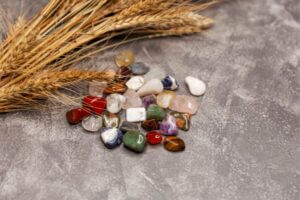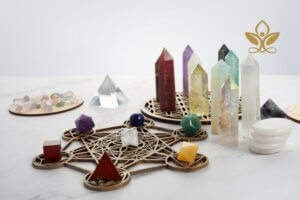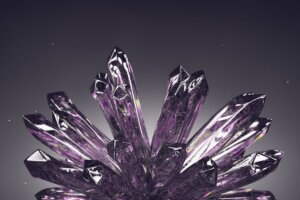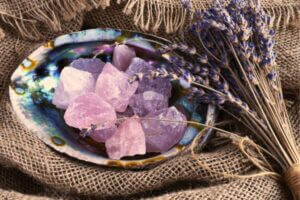Welcome to another in a series of posts about crystals with this post being about crystal structure. Of course, the dazzling thing about crystals is their spectacular sparkles. And, they have dazzled us throughout all the ages. But how do crystals get their dazzling sparkles?
The name “crystal” derives from the Greek word “Krystallos”. Do you know why the ancient Greeks gave the name “Krystallos” to the rock? Ancient Greeks thought crystals were made of ice that’s frozen so hard it could never melt. Interestingly, the myth about “frozen” and “can’t melt” in regard to quartz carried on for generations. It was only recently dispelled in the 18th century. The name “Quartz” has a similar story. “Quartz” is a German word derived from the Polish word “Kwardy” which translates to “hard“.
Ancient scientists define crystals as solid materials whose molecules are highly ordered into microscopic structures. You will find that this definition is remarkably close to what they say about crystals today. I say “remarkably” because ancient scientists had no instrumentation as they do today to take such measurements.
What You Need to Know About How Crystals Get their Dazzling Sparkles Share on XThe delightful thing is, all crystalline materials have one thing in common. That is an internal structure of regularly repeating three-dimensional patterns. In addition, every crystalline from any source, even the most irregular or misshapen shares this atomic crystal structure.
The Right Conditions for the Dazzling Sparkles of Crystal Structure
As we’ve said in previous posts, the absolute right conditions have to be in place for any type of crystal to form. In addition to that, it takes the right combination of ingredients although the variety is endless, for the crystal to form in just the right conditions and environment.
All these factors such as the crystal’s external shape and growth are a result of the available chemical ingredients, the prevailing conditions, and how the atoms link together. The variety of shapes that might come from that process include form cubes, needles, fibers, plates, or masses.
So, what causes crystals to grow in this variety of shapes repeatedly? The answer is in the atoms. Every crystal grows in repeated patterns based on the design within its atoms. The final shape of the crystal always follows the structure of its atoms. Remarkably, these repeated growth patterns are not only found in crystals. Many other materials grow in repeated patterns. The following material found in nature also grow in a similar repeating pattern as crystals:
- Sand
- Ice
- Liquid Crystal
- Sugar
- Chocolate
- Ceramic
- Metal
- DNA
Although theoretically, there are 230 different three-dimensional crystal lattices that form in nature, there are actually only 14 different, regularly ordered patterns in which crystals grow. The ordered patterns in which crystals grow are Crystal Lattices. Scientists illustrate crystal lattices as “space lattices”. You see them on diagrams as “balls and spokes”. To clarify, the balls represent the atoms and the spokes represent the ionic bonds that hold them together.
Self-Replication of Crystal Structure
One amazing fact about crystals is that they self-replicate. Self-replication is the act of an object or organism reproducing itself by its own power. In other words, a crystal has the power to make an exact copy of itself. Crystals are one of the few non-living structures that spontaneously self-replicate.
Self-replication is the process of fragments of crystals producing new crystals. Each fragment contains all of the internal molecules necessary for an exact copy. The molecules are like little microscopic building blocks that interact with each other over time to create new molecules. Eventually, patterns begin to form based on the template within the molecules.
Crystals self-replicate as their external layer provides an atomic template for the next stage of growth. Next, they continue to add layers that match the original layer. Meanwhile, they are affected internally by the conditions of growth in their environment.
Amethyst Cluster

Crystal Symmetry
Crystal lattices first separate into seven crystal systems. After that, the systems further separate into 32 classes of crystals. This is also the number of different combinations of centers, places, and axes of symmetry possible. Different types of crystals display different types of symmetry. But all crystals made of the same substance have the same symmetry. There are three types of Crystal Symmetry:
Axes of Symmetry
To understand Axes of Symmetry, first, imagine a line going through the center of a crystal. When the crystal rotates 360 degrees, it will appear to have the same symmetry more than once. Axes of Symmetry is how many times the crystal appears to be the same when it rotates on its axis. For example, a “two-fold” axis of symmetry is repeated every 180 degrees. While a “three-fold” repeats every 120 degrees.
Center of Symmetry
This is the exact center of a crystal. To under stand Center of Symmetry, imagine a point in the center of a crystal. It is a point where, if two lines were drawn from that point, they would connect with the surface at equal distances. That is the center of symmetry.
Plane of Symmetry
This is an imaginary “plane” which divides the crystal into two equal parts. Just imagine the crystal divided into two halves that are mirror images of each other. For example, a crystal with a cubic structure has 9 planes of symmetry. This means there are 9 ways to divide a cubical crystal into equal halves, i.e., 9 planes of symmetry. . This means there are 9 ways to divide a cubical crystal into equal halves, i.e., 9 planes of symmetry.
The Seven Crystal Systems
As I mentioned before, there are seven crystal systems. These crystal systems are what mineralogists use to identify crystals. A mineralogist is a scientist who studies crystal structure. They use these seven crystal systems as general designators to differentiate the types of crystal shapes. For example, if a crystal has 9 planes of symmetry and 13 axes per “center of symmetry”, then it is a cubic crystal system. Diamond and Garnets fall into this Crystals system. Another example is a Trigonal crystal system. Crystals in this system have 5 planes of symmetry and 5 axes per “center of symmetry”.
The most common crystal system found in nature is the Hexagonal crystal system. Crystals in this system will have 7 planes of symmetry and 7 axes per “center of symmetry”. Emeralds and Aquamarine fall into this crystal system.
Following this table, you will see a few examples of the crystals listed here. But, first, here are the seven systems of the crystal structure.
| Crystal | Common Forms | Symmetry |
| Cubic/Isometric: e.g. Diamond, Garnet | Cube, Octahedron | 9 planes of symmetry, 13 axes, a center of symmetry |
| Hexagonal: e.g. Emerald, Aquamarine | Prism, Bipyramid | 7 planes of symmetry, 7 axes, a center of symmetry |
| Tetragonal: e.g. Zircon, Rutile | Four-sided Prism, Tetragonal Bipyramid | 5 planes of symmetry, 5 axes, a center of symmetry |
| Trigonal: e.g. Quartz, Sapphire | Prism, Rhombohedron | 3 planes of symmetry, 4 axes, a center of symmetry |
| Triclinic: e.g. Turquoise, Sunstone | Pinacoid | No planes of symmetry or axes, a center of symmetry |
| Orthorhombic: e.g. Peridot, Topaz | Rhombic Prism, Pyramid, Dome Terminations | 3 planes of symmetry, 3 axes, a center of symmetry |
| Monoclinic: e.g. Jadeite, Moonstone | Prism, Pinacoid | 1 plane of symmetry, 1 axis, a center of symmetry |
Here are a few examples from the table above.
Garnet and Diamond Pendant

Turquoise ring

Topaz ring

The Book of Crystal Healing by Liz Simpson

Thank you for reading!
It is our wish that you find this post enlightening and helpful. If you have any questions or suggestions, we love to hear from you in the comments below. Also, kindly accept our invitation to join our group on Facebook to surround yourself with kindred spirits and post your encouraging messages.













































